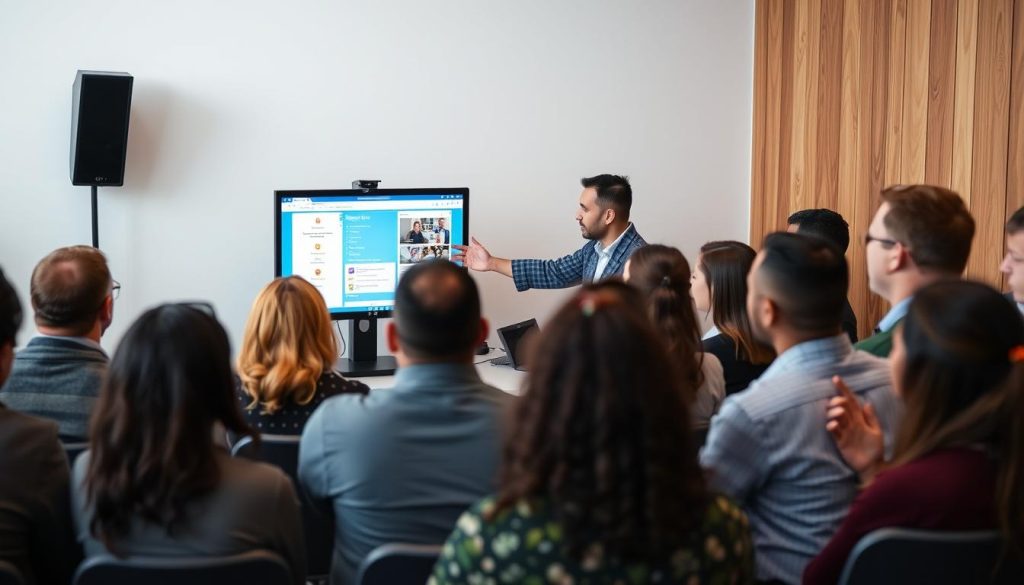Software products now cater to a wide range of users, including those without tech expertise. Promoting to non-tech audiences needs a strategic approach. This involves simplifying features, showcasing real-world benefits, and using effective marketing channels.
Understanding non-tech users’ needs helps software companies broaden their appeal. This strategy can help reach a larger customer base. It’s crucial to focus on practical benefits rather than technical specifications.
Key Takeaways
- Identify your target non-technical audience and understand their pain points and preferences.
- Craft a clear value proposition that emphasizes the practical benefits of your software.
- Simplify technical jargon and leverage visuals, analogies, and plain language to explain your product’s features.
- Utilize content marketing, social media, and influencer collaborations to reach non-tech consumers.
- Optimize your online presence and marketing strategies for search engine visibility.
Identifying Your Target Audience
Understanding your target users is crucial for promoting software to non-tech audiences. Conduct thorough target audience research to uncover their needs and preferences. Analyze the behavior of non-technical consumers to develop a clear marketing strategy.
Understanding Non-Technical Users
Non-technical users prioritize practical applications and ease of use over technical specifications. They focus on tangible benefits that solve their everyday problems. Analyzing the non-tech user analysis helps identify key factors influencing their purchasing decisions.
Defining Buyer Personas
Create detailed buyer personas based on research and data. These profiles represent different user segments within your target market. Buyer persona development helps tailor your marketing to address specific needs and pain points.
By defining these profiles, you can make your software more appealing to non-technical consumers. This approach ensures your messaging resonates with your intended audience.
| Persona Attribute | Persona A | Persona B | Persona C |
|---|---|---|---|
| Age | 35-45 | 45-55 | 55-65 |
| Occupation | Small Business Owner | Nonprofit Manager | Retired Professional |
| Pain Points | Time-saving, Efficiency | Budgeting, Reporting | Accessibility, User-friendliness |
| Preferred Communication | Email, Online Tutorials | Webinars, One-on-One Support | Phone Calls, In-Person Demos |
Thorough target audience research and clear buyer persona development are key to success. These elements help craft a software marketing strategy that truly connects with non-technical consumers.
Crafting a Clear Value Proposition
A compelling value proposition is key when promoting software to non-technical audiences. It should highlight your product’s benefits and uniqueness. This approach helps appeal to non-tech buyers and improves product positioning.
Research your non-technical target audience’s challenges and preferences. Identify the problems your software solves and its tangible value. Create a brief, benefit-focused statement that shows how your product improves users’ lives or businesses.
- Clearly define the primary benefits of your software, such as increased productivity, cost savings, or improved decision-making.
- Highlight the unique features or capabilities that set your product apart from competitors, leveraging market differentiation.
- Avoid technical jargon and industry-specific terminology, focusing on the value proposition in plain, easy-to-understand language.
- Validate your value proposition by gathering feedback from non-technical users and refining it based on their insights.
A compelling, user-centric value proposition effectively communicates software benefits. It positions your product as the top choice for non-technical buyers.
“The key to effectively promoting software to non-tech audiences is to focus on the value it provides, not the technical features.”
| Value Proposition Element | Example for Non-Tech Buyers |
|---|---|
| Primary Benefit | Increase productivity by 30% through simplified task management and automated workflows. |
| Unique Differentiator | Our intuitive drag-and-drop interface makes it easy for anyone to customize the software to their specific needs. |
| Compelling Outcome | Streamline your business operations and save valuable time, allowing you to focus on growing your company. |
Simplifying Technical Jargon
Selling software to non-techies can be tough. It’s hard to explain complex features simply. The key is to avoid jargon and use visuals. This makes your software easier to understand and more appealing.
Using Plain Language
Talk to non-tech customers in everyday words. Skip technical terms and confusing acronyms. Focus on how your software helps in real life. Describe its benefits in a clear, simple way.
Leveraging Visuals and Analogies
Use images, infographics, and videos to explain your software. These tools make complex ideas easier to grasp. Compare your software to familiar things. This helps users understand how it works and why it’s useful.
| Technique | Example |
|---|---|
| Visual Communication | Illustrate the software’s features with clear and engaging visuals that demonstrate its capabilities. |
| Analogies and Metaphors | Explain technical aspects of your software by comparing them to everyday objects or experiences, such as “Our project management tool is like a digital to-do list that keeps your team on track.” |
| Plain Language | Describe the software’s functionalities using simple, jargon-free language that your target audience can easily understand. |
Simple words and clear visuals make software easier to understand. This approach helps non-tech users see the value in your product. As a result, more people will want to use it.

Leveraging Content Marketing
Content marketing is a powerful tool for promoting software to non-technical users. Engaging blog posts and informative video tutorials can educate your audience. These methods build trust and showcase the value of your software offerings.
Creating Engaging Blog Posts
Crafting compelling blog content is crucial for software companies targeting non-technical audiences. Focus on addressing the pain points and needs of your users. Use clear language and avoid technical jargon that may confuse readers.
Incorporate visuals like images and infographics to enhance the user experience. These visual aids make complex concepts easier to understand and digest.
Utilizing Video Tutorials
Video content is invaluable when promoting software to non-tech audiences. Create informative and visually engaging video tutorials to demonstrate key features and functionality. Cover topics such as onboarding, common use cases, and troubleshooting.
These resources help users feel confident in using your software. They provide step-by-step guidance in an easy-to-follow format.
| Content Marketing Tactic | Benefits |
|---|---|
| Engaging Blog Posts |
|
| Informative Video Tutorials |
|
Content marketing tactics help software companies reach non-technical audiences effectively. Engaging blog posts and informative video tutorials connect with users. These methods build trust and highlight the value of your products.
How To Promote Software To Non-Tech Audiences
Promoting software to non-tech audiences requires a strategic approach. Focus on simplifying jargon, using visual aids, and creating engaging content. Understanding user needs helps develop effective marketing tactics for new segments.
Craft a clear value proposition in plain language. Highlight how your software solves customer problems. Use analogies and real-world examples to explain features.
Content marketing is a powerful tool for non-tech audiences. Publish blog posts, create video tutorials, and host webinars. Address specific challenges and interests.
Make content easy to understand and visually appealing. Focus on practical solutions that resonate with non-technical users.
Social media connects you with non-tech users effectively. Identify platforms where your audience is active. Share valuable, educational content showcasing your software’s capabilities.
Collaborate with industry influencers to extend your reach. This can boost your credibility among non-technical audiences.
These strategies help promote software to non-tech audiences effectively. Expand your customer base and drive long-term growth for your business.
| Tactic | Description | Key Benefits |
|---|---|---|
| Simplify Technical Jargon | Use plain language and relatable analogies to explain complex features and functionalities. | Improves comprehension and reduces barriers to adoption for non-tech users. |
| Leverage Content Marketing | Create engaging blog posts, video tutorials, and webinars that address the needs and interests of your target audience. | Establishes your brand as a trusted resource and helps educate potential customers. |
| Engage on Social Media | Identify relevant social media platforms and share valuable, educational content that showcases your software’s capabilities. | Facilitates direct interaction with non-tech users and helps build brand awareness. |

“The key to promoting software to non-technical audiences is to focus on simplicity and value. Speak their language, and demonstrate how your product can make their lives easier.”
Engaging on Social Media
Social media is a powerful tool for promoting software to non-technical audiences. You can reach these users by finding the right platforms. A strategic content plan helps engage them effectively.
Identifying Relevant Platforms
Not all social media platforms are equal for software marketing. Analyze demographics and user behavior to connect with your non-tech audience. LinkedIn and Twitter suit professionals, while Facebook and Instagram attract a broader base.
Research where your target users are most active online. Evaluate platform features to align with your content strategy and marketing goals. Consider how to showcase your software visually on Instagram and YouTube.
- Conduct research to understand where your target users are most active online.
- Evaluate the features and capabilities of different social media platforms to determine which ones align best with your content strategy and marketing goals.
- Consider the visual nature of your software and how it can be effectively showcased on platforms like Instagram and YouTube.
Sharing Valuable Content
Focus on providing educational content that addresses user pain points. Show the benefits of your software without using sales pitches. This approach helps build trust with your audience.
- Create blog posts, videos, and other content that explains the key features and use cases of your software in simple, non-technical language.
- Engage with your followers by responding to comments, sharing user-generated content, and hosting Q&A sessions.
- Leverage social media’s visual nature by showcasing your software’s user interface, data visualizations, or other visual elements that can effectively communicate its capabilities.
Build engagement by providing relevant, educational content. This approach fosters a loyal following. It positions your software as a trusted solution for non-technical users.
Collaborating with Influencers
Teaming up with industry influencers can boost your software marketing to non-tech audiences. These partnerships can build trust and expand your reach. You can effectively showcase your product’s value through respected individuals with strong followings.
Identifying the right partners is crucial for influencer marketing for software. Look for those who align with your brand and understand your target market. Partnering with industry experts can provide valuable insights and perspectives.
Building trust with non-tech audiences is possible through an influencer’s personal brand and endorsement. Focus on creating authentic and mutually beneficial partnerships. This may involve co-creating content or hosting joint events.
Leverage the influencer’s existing reach and credibility to showcase your software’s features. This approach can expand your brand’s visibility and communicate your value to a broader non-technical audience.
| Influencer Characteristics | Benefits of Influencer Partnerships |
|---|---|
|
|
Carefully select and collaborate with the right influencers to promote your software effectively. This strategy can help in building trust and expanding your reach among non-technical audiences.

Hosting Webinars and Demos
Webinars and product demos are powerful tools for showcasing software to non-technical audiences. They help communicate your product’s value effectively. These interactive presentations address user needs and concerns directly.
Preparing Effective Presentations
Simplify technical jargon when creating webinars for non-tech users. Focus on practical benefits of your software. This approach ensures your message resonates with your audience.
- Avoid complex terminology and industry-specific language. Instead, use plain, conversational language that your audience can easily understand.
- Leverage visuals, such as simple diagrams and analogies, to explain complex concepts in a relatable way.
- Prioritize hands-on demonstrations that allow participants to see the software in action and understand its real-world applications.
- Incorporate interactive elements, like live Q&A sessions, to address any questions or concerns your audience might have.
These best practices help create engaging webinars and demos. They showcase your software’s features and benefits clearly. This approach helps engage non-tech users and sparks interest in your product.
“Interactive product presentations are a game-changer for connecting with non-technical audiences and showcasing the true value of your software.”
Leveraging Referral Programs
Referral marketing boosts software promotion to non-tech audiences. It taps into word-of-mouth promotion by rewarding existing users. This method builds a loyal user base through friend and family recommendations.
Create a program that rewards users for successful referrals. Offer discounts, free trials, or perks to both referrer and new user. Keep the process simple for non-tech-savvy individuals to easily participate.
Target specific non-technical user segments for maximum impact. Tailor incentives for small business owners, healthcare professionals, or stay-at-home parents. These groups often have wide networks of potential customers.
Highlight practical benefits of your software to encourage non-tech referrals. Show how it improves daily life through engaging content and visuals. Showcase user-friendly features and real-world applications for easy sharing.
Make the referral process seamless and rewarding for your non-technical audience. Empower users to spread the word effectively. This approach taps into word-of-mouth promotion and helps build a loyal user base.
| Referral Program Strategies | Benefits |
|---|---|
| Offer Discounts or Free Trials | Incentivizes users to share your software and attracts new customers |
| Provide Referral Rewards | Encourages existing users to actively promote your software to their networks |
| Target Specific Non-Tech Segments | Tailors your referral program to the needs and interests of your target audience |
| Emphasize Practical Benefits | Helps non-technical users understand the value of your software and share it confidently |

Referral marketing for software unlocks vast potential for growth. It harnesses word-of-mouth promotion to build a loyal user base. A well-crafted program can be a game-changer in promoting your software to a wider audience.
Optimizing for Search Engines
SEO is vital for software marketing success. It boosts visibility and reaches non-technical audiences. Proper keyword research and on-page optimization can help you connect with more potential customers.
Keyword Research
Start by finding the right keywords for your software. Research terms your target audience uses to search for similar solutions. Look at search volume, competition, and relevance to pick valuable keywords.
- Utilize keyword research tools to explore relevant terms and phrases.
- Prioritize keywords that have significant search volume and align with your software’s features and benefits.
- Analyze the search intent behind each keyword to ensure you’re targeting the right audience.
On-Page SEO Techniques
After choosing keywords, optimize your online presence. Use on-page SEO to improve visibility and help non-technical users find your software.
- Incorporate target keywords seamlessly into your website’s content, including page titles, headings, and body text.
- Optimize your software’s meta tags, image alt text, and URL structure to enhance search engine crawling and indexing.
- Ensure your website is mobile-friendly and has a fast loading speed to provide a positive user experience.
SEO strategies can boost your software’s visibility. They help you reach a wider audience, including non-technical users seeking solutions to their problems.
Measuring and Analyzing Results
Tracking your software promotion efforts is vital for improvement. Monitor key metrics like website traffic and conversion rates. These insights help refine your marketing strategies for non-technical audiences.
Performance tracking reveals which tactics resonate with your target audience. Use this data to optimize content and messaging. Adjust your social media presence based on these insights.
Stay agile and responsive to data for effective strategies. This approach aligns with your non-technical customers’ evolving needs. It ensures your promotional efforts remain impactful.
Continuous improvement drives long-term success in software promotion. Regular analysis informs decisions that boost growth. It helps better connect your solutions with non-technical users’ needs.
A data-driven approach keeps you competitive in software marketing. It enables you to navigate the changing landscape effectively. This method ensures your promotions stay relevant and effective.




